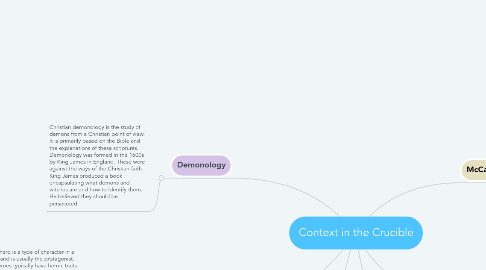Context in the Crucible
by Rosabella Louise Deakin

1. Demonology
1.1. Christian demonology is the study of demons from a Christian point of view. It is primarily based on the Bible and the explanations of these scriptures. Demonology was formed in the 1600s by King James in England. These were against the ways of the Christian faith. King James produced a book encapsulating what demons and witches are and how to identify them. He believed they should be persecuted.
2. Tragedy and the Tragic Hero
2.1. A tragic hero is a type of character in a tragedy, and is usually the protagonist. Tragic heroes typically have heroic traits that earn them the sympathy of the audience, but also have flaws or make mistakes that ultimately lead to their own downfall. They also have 4 common traits, Hamartia (downfall), Hubris (excessive pride and disrespect), Peripeteia (reversal of fate), Anagnorisis (Important discovery). The text is an tragedy and thus calls for a tragic ending
3. Arthur Miller's life and works
3.1. He was in a relationship with Marilyn Monroe. Born in 1915 in Harlem, he joined a theatre company in his later life. The Crucible was his way of making parallels between 1940s America and the Salem Witch Trials.
4. McCarthyism
4.1. McCarthyism is the practice of making accusations of subversion or treason without proper regard for evidence. - This was adopted by McCarthy in the late '40s and through the '50s in the USA. Those persecuted were apparently communists (due to growing fears in the USA). Miller himself was actually tried in 1958 by HUAC due to a supposed confession by Eliza Kazan in 1952.
5. Puritanism
5.1. The beliefs or principles of a group of English Protestants of the late 16th and 17th centuries who regarded the Reformation of the Church under Elizabeth I as incomplete and sought to simplify and regulate forms of worship. Often with censorious moral beliefs, especially about self-indulgence and sex. This served as the basis of religion around the time of the Salem Witch trials as people migrated from England to Salem where the novel is set.
6. Salem Witch Trials
6.1. The Salem witch trials were a series of hearings and prosecutions of people accused of witchcraft in colonial Massachusetts between February 1692 and May 1693. More than 200 people were accused, 19 of whom were found guilty and executed by hanging (14 women and 5 men). This was the basis story of the Crucible however most characters were made up off of real people apart from one whose name was kept.


